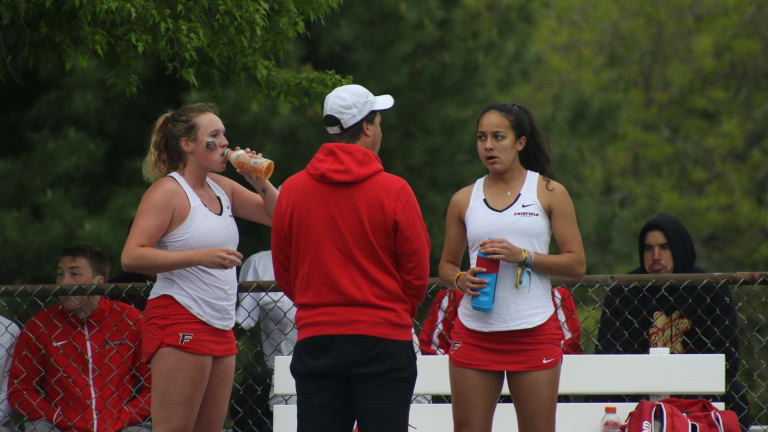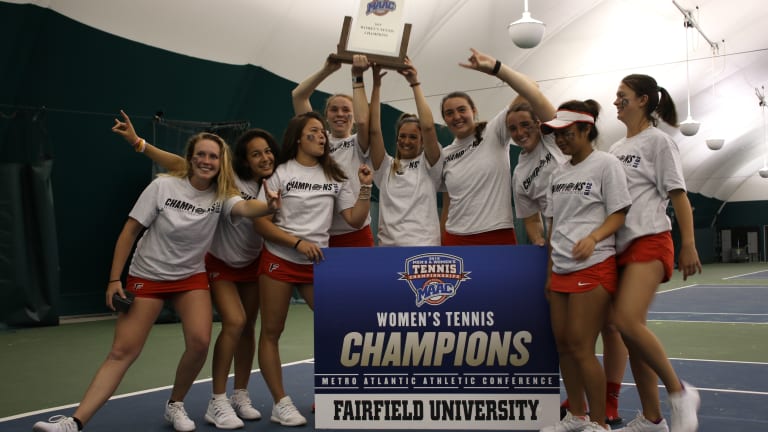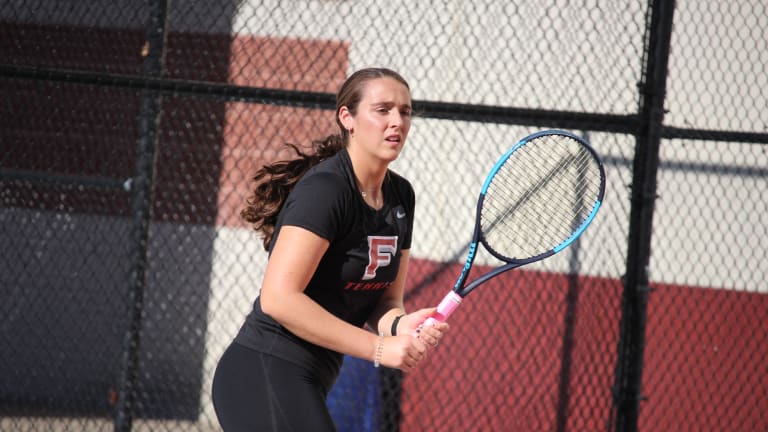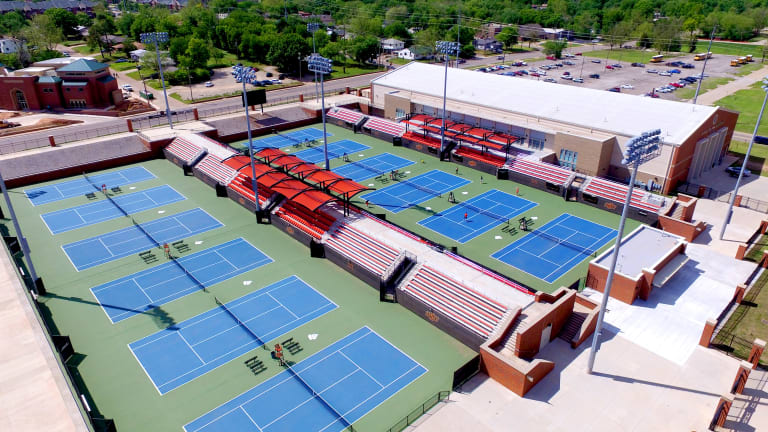March Sadness: An inside look at Fairfield tennis as COVID-19 struck
By Ed McGrogan Apr 07, 2020San Diego Open
ATP cancels China swing, including Shanghai Masters, and adds six 250 events to 2022 calendar
By TENNIS.com Jul 21, 2022Australian Open
Pandemic surge hits Australian Open: Bernard Tomic's COVID-19 prediction comes true, spectators capped at 50 percent
By Kamakshi Tandon Jan 13, 2022Australian Open
Novak Djokovic has been exempted—but his stance hasn’t been vindicated
By Steve Tignor Jan 04, 2022Australian Open
Rafael Nadal back on track for Australian Open following COVID-19 case
By Kamakshi Tandon Dec 30, 2021Australian Open
Aussie Open field starts to experience effects of pandemic surge, vaccination issues
By Kamakshi Tandon Dec 21, 2021"It will happen this year": Stefanos Tsitsipas planning to get COVID-19 vaccine
By Kamakshi Tandon Sep 21, 2021US Open
Going to the US Open? Proof of vaccination status now required after change in COVID-19 policies
By TENNIS.com Aug 27, 2021US Open
A vaccinated Sofia Kenin to miss 2021 US Open due to positive COVID-19 test
By Matt Fitzgerald Aug 26, 2021Australian Open
The Rally: if you wanna play a major, you must play by the local rules
Jan 18, 2021March Sadness: An inside look at Fairfield tennis as COVID-19 struck
In victory or defeat, college tennis teams make lasting memories. Fairfield University’s women’s team was doing more of the former, until the coronavirus took it all away.
Published Apr 07, 2020
Advertising
Over the next three days, we'll look at how the coronavirus crisis has impacted one aspect of tennis in a particularly cruel way: the college game.
On Monday, Steve Tignor looks back on a season at the top for the University of Southern California men's team—before it suddenly stopped. He also speaks with Joel Drucker, in the #MondayRally, about the communal side of college tennis, and if it can be replicated elsewhere in the sport.
On Tuesday, Ed McGrogan writes about Fairfield University's women's team, which made an unlikely run to the NCAA Tournament in 2019. But in covering the mid-major school this March, he got an up-close look at the abrupt sadness that followed.
On Wednesday, Nina Pantic examines the NCAA's ruling that grants spring-sports athletes another year of college eligibility, if they so choose.
Fairfield University’s proximity to New York City—and the metropolis’ coveted internships students crave—has always been a selling point to potential recruits. But in the ultra-competitive world of women’s college tennis, location only goes so far. So when Wormley, with an extensive athletics history at nearby Sacred Heart and Quinnipiac, came to Fairfield as its senior associate athletic director in 2017, he made sure his new campus’ tennis program was one prospects would have a tough time turning down. That meant additional tournament travel, stylish gear (adorned with the school’s mascot, a stag) and rebranded, red-on-grey tennis courts.
It also meant personal connections—to alumni, for networking opportunities, and to the team’s do-it-all coach, Jeff Bricker. Like Wormley, Bricker has Connecticut tennis running through his veins, with bloodlines from Yale (where his stepfather was the men’s tennis coach for 30 years), Sacred Heart (as a player), Quinnipiac (where he went to law school) and the University of New Haven (as a coach for three years). He’s a Jeff of all trades.
In terms of success, Bricker’s current situation might be the most challenging he’s faced. For one, he coaches both the men’s and women’s teams at Fairfield. At practices, the 41-year-old’s head is on a swivel, with the women hitting on one side and the men on the other. And with just one assistant, Bricker traverses courts during matches like a roving reporter, doing as much as he can with each of his players in a limited amount of time. The teams’ seasons begin in late September and continue, with sporadic interruption, through late April.
“By the time the end of the season comes,” Bricker said during a February practice, “I need a break.”

March Sadness: An inside look at Fairfield tennis as COVID-19 struck
Advertising
Bricker (center) saw great potential in his women’s team heading into the 2018-19 season, including freshmen Nowak (left) and Aina March (right). But he didn’t know what he really had until the Stags went on a surge in conference play. “He somehow recruits kids that get along, and buy into the whole thing,” said Paige about Fairfield’s makeup. “That’s probably the thing about a mid-major,” explained Bricker—“hopefully, if we’re doing it right, it’s a family atmosphere.”
To get to that practice, Bricker drove both of his teams north from campus to the town of Trumbull, where a Fairfield alum owns an indoor tennis facility. The players streamed out of the cramped white van like water from an open spigot.
Such is the life Bricker has chosen: heading a mid-major school in NCAA Division I tennis. Fairfield, a private university with about 5,000 students, is by no means wanting for resources, but its tennis program isn’t fully funded (a fully-funded women’s tennis program offers eight full scholarships), which will always keep it a rung below the blue bloods.
“We want to bring in the best and the brightest,” Bricker said of his recruits, “but we also have to coach them up. We have to develop them. We have to come up with different ways to bridge that gap.”
The previous day, Bricker had walked the equivalent of city blocks while coaching his women’s side against Manhattan-based Columbia. The Lions were a Top 25-ranked team whose Ivy League cachet ensured itself a well-stocked roster.
The banners of Columbia’s fellow Ivies, including Yale, Princeton and Harvard, hung above the courts at the Dick Savitt Tennis Center. But what flashed on the scoreboards was just as imposing. On Court 4: Lions lead Guest 6–0, 2-1. On Court 3: Lions lead Guest 6–2, 2-0. Seven minutes later, only one of the six matches going was closer than a set-and-a-break margin.
Columbia won the dual match, which consists of a doubles point and six singles matches, 7–0, in less than two hours. That was OK, insisted the guest.
It was “a rehearsal,” said Ed Paige, Fairfield’s coordinator of tennis operations and former head coach.
“I actually love playing teams like Columbia, because they’re really good players and really big hitters,” said Stag sophomore Sophia Prinos, who lost her match 6–1, 6–0. “I see those matches as experience to improve upon. Those matches are fun for me.”
“If we can play like that all spring, we will be in good shape,” said Bricker.
There was reason for optimism: First, Fairfield was missing its star player, sophomore Amanda Nowak. The Metro Atlantic Athletic Conference’s Rookie of the Year—and Player of the Year—as a freshman, Nowak came to Fairfield in part because her dad played hockey there when the school still iced a team. It’s the kind of luck mid-major programs need to bridge the unmistakable talent gap in college athletics. (As opposed to bad luck, like when a serve struck Nowak in the head during doubles practice just before the Columbia match, causing her to be sat out with a concussion.)
Another way to bridge the gap is to field a team whose whole is greater than the sum of its parts. Fairfield’s magical 2018-19 season was that proverb personified.

March Sadness: An inside look at Fairfield tennis as COVID-19 struck
Advertising
Fairfield won six of its last seven conference matches in the spring of 2019, including a narrow MAAC Championship victory over rival Quinnipiac, to reach the NCAA tournament for the first time since 2012. “It set the momentum for the rest of our years [here],” said Sophia Prinos, a freshman during the title run. “This is what we want every year.”
“They all seemed so close—I liked the energy the girls gave during the official visit,” Nowak said. “They just seemed to have a connection that some of the other teams I met didn’t.”
In the college-tennis arms race, Fairfield had landed one of the best arms in the country. And for a program that hadn’t won the MAAC—and, in turn, a ticket to the NCAA tournament—since 2012, it was needed.
The team began the 2019 calendar year with one-sided defeats to Yale and St. John’s at a kickoff exhibition, followed by a 5–2 loss to the same St. John’s team six days later. Their road trip continued with a stop in Rhode Island to face Bryant. A year earlier, the Bulldogs had beaten the Stags 7–0.
Trailing 3–1—Nowak earning the only point—the Stags went on to take all three must-win points for an unlikely triumph. Fairfield, which had gone 13–44 in its three prior seasons, would begin its 2018-19 season 7–1.
“Those matches tend to galvanize a team, and make them believe,” said Bricker. “When you’re a young team, you have to get wins, otherwise they don’t really believe.
“That was always the question last year: do we have too much youth?”
Fairfield’s inexperience would be tested after enduring a five-match losing streak, with the meat of conference play set to begin. But that’s when the team grew up before Bricker’s eyes. The Stags won five of their last six matches to close out the regular season, including a 4–3 victory over Marist that saw Nowak earn the clinching point in a third-set tiebreak.
The two schools reconvened in the MAAC Championship semifinals, with the Red Foxes taking the doubles point for a 1–0 lead. Fairfield promptly won four singles matches to advance.
The Stags’ last obstacle were the Quinnipiac Bobcats, a MAAC goliath which came into the final having won 54 consecutive matches against conference opponents. Again, Fairfield lost the doubles point, and would trail 3–2. But a straight-sets win by Nowak, and a decisive, three-set win by Jessica Pil—via match violation, after five missed calls were overruled by the umpire—gave Fairfield everything its players, the coaches and the administration had worked so hard for.
“Last year, I thought we were good enough,” Bricker said, “but with their youth, I thought [a championship] could be one year away.”
Fairfield’s women’s tennis team had arrived a year ahead of schedule, which only increased expectations. An unsurprising defeat to No. 6 seed and perennial power Pepperdine in last year’s NCAA Tournament gave the Stags added motivation this season—particularly the seniors, Pil, Emily Lombardi and Diana Prinos.
“I get chills thinking about it,” Prinos said with a beaming smile, recalling the cross-country trip. “We had joked about it while we were watching the [tournament selection]: ‘What if we got Pepperdine?’ We were so ecstatic.”
Bricker crafted a more challenging schedule for his teams in 2020, including a spring trip to the USTA National Campus in Lake Nona, Fla. It was the kind of travel Wormley had built into the program on an annual basis to help recruit Fairfield’s future, while also bolstering its present.
“Spring training is the time when everyone’s got their head on straight,” said Wormley. “We’ve got four great matches and we’ll come back better.”
“By the time we get to our conference,” added Bricker, “we’re going to be ready to go, battle-tested.”
On March 6, Fairfield was four days away from playing its first match in Lake Nona. I wished Bricker good luck. We shook hands.

March Sadness: An inside look at Fairfield tennis as COVID-19 struck
Advertising
Diana Prinos is one of four Fairfield tennis seniors that didn’t get a chance to leave the college game on their own terms. “I’m heartbroken that we won’t get to honor them by finishing out their senior years,” said Bricker, “but I will cherish every minute I’ve had with them, and know they will be amazing contributors to the greater world we live in.”
BRICKER: We arrived in Lake Nona on Monday morning, got in a practice and went about our normal business.
PAIGE: I arrived in Orlando on Tuesday morning, March 10. I met the teams at the National Campus to watch and coach their matches. It was kind of weird at the site. Everyone knew what was going on, but tried to go about their day. I think the semi-denial worked; the men and women got lost in their play.
BRICKER: It was Wednesday morning that I started to become concerned that this was going to be an issue. The players also started to worry, as they saw the issues pop up with the NBA and other sports leagues. From that point on, I was communicating pretty regularly with senior administration to determine what we should do.
PAIGE: During women’s play one of our best players, Sophia Prinos, got hurt. She slipped and broke her wrist trying to break her fall. Our admin and Sophia’s sister Diana took her to the emergency room. The next morning, Sophia flew back to Boston for surgery. Wednesday night both teams and coaches had an Italian dinner together.
PAIGE: Thursday morning everything changed. We started to hear of all sports cancelling tournaments. The MAAC was having a conference call to let us know what would happen. The teams were holed up in their condos, awaiting word. At first the league said to continue competition until Sunday.
BRICKER: By midday Thursday, we knew we needed to get back to campus, and I worked with the airlines to get the arrangements made.
BRICKER: I brought each team together once I received word that the season was being cancelled and broke the news to them in person. It was a very difficult conversation to have, especially for the seniors, as their final years were taken away.
Obviously the vibe was one of sadness, but I reminded them that life throws you curveballs, and you have to adjust. Losing the spring season doesn’t change who we are or what we are about; that will never define us. It’s the relationships we’ve made and the hard work we’ve put in, collectively and individually, that will make us special.
We tried to reminisce about good memories. Ultimately, everyone understood that this was way bigger than sports, and we needed to get back to campus and to our families.
PAIGE: It just seemed that we had so much bad luck on the women’s side this year. In the fall, one of our top players had to shut it down and was scheduled for back surgery before the pandemic hit. Was it karma? Were the tennis gods paying us back for such an exemplary season the prior year? Who knows.
It was such an abrupt and sad end. I can only imagine what the seniors felt.

March Sadness: An inside look at Fairfield tennis as COVID-19 struck
Advertising
The Michael and Anne Greenwood Tennis Center, part of Oklahoma State University’s Athletic Village, was built in 2014 and slated to host the 2020 NCAA Division I Tennis Championships. “Over the last four years we have continued to make facility improvements and raise funds in the hopes of putting on the best Championships possible,” said Young. “We were going to initiate several new concepts into the Championships, which I hoped would be impactful in bringing more people to the matches.”
Unlike the ATP and WTA tours, which will resume at some point with the players and tournaments we know, there is no chance of college tennis returning until the next academic year. It’s a brutal reality for teams who viewed last season as one they’d been building toward; for loyal fanbases throughout the United States; and for schools that had planned significant events—like Oklahoma State University, which, after years in the making, was scheduled to host the 2020 NCAA Division I Men’s and Women’s Tennis Championships.
“When I arrived here in 2009 I had a vision of building a facility that would one day give us the chance to host the NCAA National Championships in Stillwater,” said Chris Young, director of tennis and head women’s coach at Oklahoma State. “I felt it would help elevate tennis in our community, our state, and bring awareness about what a great product college tennis really is.
“It is a sad day to be so close to the event happening and have it cancelled after so much planning and effort. I remain hopeful we will get another shot, sooner rather than later.”
Then there are the players, who will never know how they would have fared, individually or as part of a team. Fairfield, whose 2019-20 season will officially go down as 3–8, never had the opportunity to rally in conference play, like it did the year before.
But it’s the seniors who will feel the most pain. The vast majority of these upperclassmen, now completing their studies through online coursework, will never play tennis at this level again. (The NCAA has granted spring-sport athletes an extra year of eligibility, but they would need to put their post-college lives on hold in order to return.) They’ll graduate with a degree and a void that will always be incomplete.
Diana Prinos is among the unlucky, though her name will remain part of the Stags’ future, once her sister and fellow nursing major Sophia recovers from surgery. But in another way, Diana was one of the lucky players in this nightmarish season. Before social distancing became a household term, she recognized that nothing in life—or tennis—is guaranteed. It’s a perspective that will serve her well graduation.
“Sometimes as a senior, you forget that this is the last time you’re going to be playing college tennis—you take it for granted,” she said in February. “I want to play every match as if it’s my last match, put everything into practice as if it’s my last practice, and absorb every moment as if it’s my last.”

March Sadness: An inside look at Fairfield tennis as COVID-19 struck